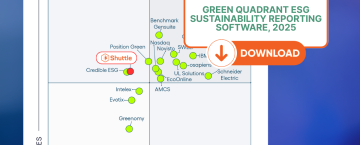Building Your 2025 Sustainability Blueprint (and beyond): Expert CSRD Compliance & ESRS Updates
The Corporate Sustainability Reporting Directive (CSRD) is reshaping how organisations manage ESG data, but compliance alone won’t secure competitive advantage. On 19 June 2025, our one-hour webinar brought together:
Luke Gowland, Senior Analyst, Verdantix
Dr Liad Ortar, Senior Technical Manager, EFRAG
Laure Razat, Sustainability Solutions Director, kShuttle
Before going on to these key steps, don’t hesitate to access the webinar replay via this form below ⏬
Now let’s go back to this practical manual.
Think of this as your user guide to turning CSRD compliance into strategic advantage. Follow these four steps (straight from our expert panel’s webinar), to build a sustainability blueprint that delivers real business value in 2025 and beyond.
Step 1 – Embed CSRD into Core Business
“Final CSRD report is kind of just the cherry on top of the cake […] ultimately for an organization to get to that point and to have that kind of final report delivered, there’s a lot of processes going on” – Luke Gowland, Verdantix
Too many organisations relegate sustainability data to a separate “compliance” team. Instead, weave ESG metrics into your everyday KPIs alongside revenue, risk and operations. That means:
Fold ESG metrics into decision-making
Treat them as business KPIs alongside revenue and risk.
Quantify your benefits
Calculate savings (e.g. reduced waste, lower audit fees) to build a solid business case.
Assemble your cross-functional crew
Involve procurement, finance and legal from Day 1.
Why this matters: embedding ESG into core business processes accelerates stakeholder buy-in and turns one-off reports into ongoing performance drivers.
Step 2 – Follow the ESRS Roadmap
Your to-do list now:
Read EFRAG’s Q&A (150+ clarifications since March).
Book workshops with your ESG and finance teams by July.
Align materiality to the forthcoming ESRS topics for smoother reporting.
Why this matters: early engagement with evolving standards prevents last-minute scrambles and ensures your disclosures hit the mark.
Step 3 – Build a Future-Proof Data Architecture
Building, while remaining clear-headed, as Luke Gowland reminds us: “treat software as an enabler, not a substitute[…] do the hard work, ensure the accountability and then software. Once you have these kind of key foundations in place, then use the software to build into more sophisticated.”
Putting this into practice, Laure Razat demonstrated kShuttle’s platform in action: it centralises data from finance, operations and supply chain, then automatically maps it into ESRS templates. Attendees saw how this combination of solid groundwork and smart tooling can slash manual effort by over 80% and deliver one single source of truth for all sustainability disclosures.
Your checklist:
Centralise your data sources – Consolidate finance, operations and supply-chain data into a unified repository.
Automate ESG mapping – Configure your platform to populate ESRS fields automatically, dramatically cutting manual work.
Enforce governance through software – Build in role-based permissions, audit trails and data validation rules.
Plan your IT roadmap – Define milestones for quarterly updates and annual disclosures, ensuring scalability.
Why this matters: with the right technical foundations, you free up your teams to analyse insights instead of wrangling spreadsheets.
Step 4 – Craft Your 2025 Sustainability Blueprint
With data, standards and strategy aligned, you’re ready to set the foundation of your 2025 sustainability blueprint. Now bring it all together:
Audit your toolset against Luke’s “business metric” criteria.
Engage with EFRAG’s drafts and host cross-team deep dives.
Design integrated workflows (ESG, finance and IT in lockstep).
Train your stakeholders on new processes and tools.
Why this matters: this holistic approach transforms CSRD from a checkbox into a competitive differentiator – throughout 2025 and beyond.
Still have questions?
Our full webinar replay answers audience queries on software selection, materiality prioritisation, and real-world implementation challenges.
📩 Ask for a demo to learn more about our solutions and services


